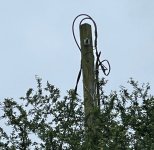wattmatters
Prominent Member
- Joined
- Sep 29, 2023
- Messages
- 929
- Reaction score
- 1,019
- Points
- 304
- Location
- Hungry Head, NSW Australia
- Driving
- MG4
Thanks for clarifying. Yeah, a small solar PV array isn't enough to cover consumption. Makes sense.My main usage will be to power a heat pump, where the main demand is in the wintertime when the power I get from my 3kW solar panels is often <<1kW. Re-charging the car batteries will be overnight, when cheaper grid power, which will also be powering the heat pump. I might expect to use 8-10 kWh for the heat pump on a cold day (a COP of 3-4 provides 25-40 kWh of heat energy). I tend to use the car only 1-2 short trips a day, so most of the time it can be supplying the home.
I have 11 kW of grid-tied PV and 2.2 kW of off-grid PV and hoping to add several more kW to my off-grid system before long (I have it there, it's just a matter of installing).
There are three separate parts to the system:With regard the car, it is at least designed to charge the EV batteries for up to 9 hours at 7kW. For someone who drives their car to work, say 100 miles return trip Mon-Fri, they would be charging for 4-5 hours every night. I think it extremely rare that I need to draw as much as 7kW for more than a couple of hours in any period. I think the vehicle battery system is well able to cope with the demands of my home requirements.
i. the battery and BMS
ii. the on-board AC charge controller 7 / 11 kW (single phase / 3-phase)
iii. the on-board V2L inverter. Note that MG4 specifications rate at 2.2 kW.
i. & ii are going to be fit for the purpose of everyday use.
iii. however may have been designed for occasional use as a handy tool but I have to wonder about deploying it for constant use and at higher rates of power draw.
There must be a reason why MG have limited the V2L output specification at 2.2 kW and why their own V2L adapter is limited to that.
I can use use the V2L output to power an AC charge controller to charge my home battery at a modest rate suitable for the on board V2L inverter.My ideal setup would allow me to use the V2L output in an on-grid configuration, but to address both earthing problems and lack of synchronisation with the grid frequency by using a dc input of a hybrid inverter to generate grid-synchronised AC output. To do this the car's V2L output needs to be converted to DC - slightly wasteful in efficiency terms, but available immediately.
As you say, this introduced efficiency losses but then my dedicated off-grid home inverter, which is designed for this duty, can supply the home power as needed. It's got an 8 kW continual output capacity.
If I really thought the car's V2L could cope with regular higher power outputs (I have my doubts) then having it dedicated to running the ducted AC system at night would be very helpful. We need the Summer cooling and occasional Winter warming. It's the major load I do not support with the home battery.
Then I can recharge from solar PV in the daytime. For instance, this day last week:
I have loads, including the water heater and the EV charge station, which automatically vary their power draw so as to remain under the solar production curve (also the off-grid battery if it needs supplemental charge). You can see this was a pretty tricky day with clouds coming and going.
But that red blob of energy in the evening is the ducted AC system drawing from the grid, while during the day the solar PV covers it.
I would love to be able to offset that evening consumption. But I would need a second inverter for that.
